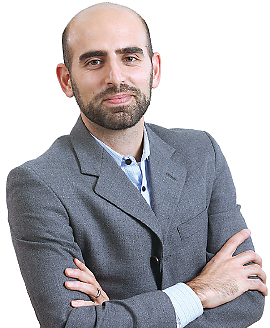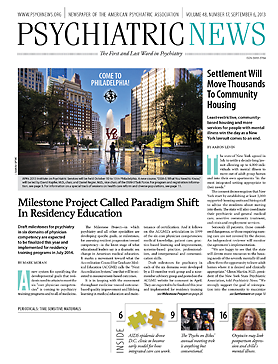When Yavar Moghimi, M.D., came to Whitman-Walker Health (WWH) two years ago to work as a staff psychiatrist, the community health center had already been practicing a version of integrated care long before it became the new trend in health care.
Like many institutions that mobilized to meet the HIV/AIDS epidemic, Whitman-Walker—located on 14th Street, N.W., in Washington, D.C., and serving the city’s gay and lesbian population—early on evolved a holistic approach to HIV/AIDS care. The severity of the illness, the threat that HIV poses to the public as an infectious agent, and the complexity of factors that contribute to behaviors associated with infection caused experts in AIDS care to recognize, as early as the late 1980s, when antiretroviral treatments were introduced, that HIV would require something more than the standard medical approach.
So WWH, and other institutions like it around the country, began to develop the kind of one-stop shopping for multidisciplinary care that today is a major new trend in American medicine under the rubric of integrated or “collaborative” care and that psychiatry has long recognized as the biopsychosocial model.
“Prior to coming to Whitman-Walker, I didn’t have much experience with HIV care, but in the time I have been here, I have really come to appreciate that what has evolved here is really a true model of biopsychosocial care,” Moghimi told Psychiatric News. “I think this was driven by the fact that there was an urgency associated with HIV as an infectious agent and a public-health issue. When the antiretroviral agents were developed, there was a recognition that the treatments work only as long as people took them, so there was a huge concern about compliance and, incidentally, reducing patients’ viral load, which is a measure of how contagious they are to the community” (see sidebar).
Today, Moghimi is one of a small but growing number of psychiatrists who have caught the “wave” of integrated, or collaborative, care. He provides education and consultation to primary care doctors at WWH about mental health issues relevant to their general medical patients and direct patient care to those in need of a more intensive psychiatric treatment.
WWH, which opened in the 1970s treating sexually transmitted diseases among D.C.’s gay population, today offers a full range of medical, dental, and mental health services, including addiction services. Additionally, WWH provides housing support, legal counsel, and coordination of access to health insurance and public assistance. There is even a public-health officer who coordinates preventive services.
Recently, WWH was designated as a federally qualified “patient-centered medical home,” providing federal assistance to support the integration of care. “There is a pretty unique sense here at Whitman-Walker that we are really ahead of the curve in terms of integrating all facets of a patient’s care,” Moghimi said.
A graduate of the George Washington University School of Medicine, where he also completed his residency, Moghimi said he did not have any training specifically around how to work in an integrated-care setting. But as a community psychiatrist, he did witness the failures and frustrations of trying to care for patients in a system in which general medical care and mental health care were not coordinated.
“Prior to coming to Whitman-Walker, I worked in a community mental health center here in D.C.,” he said. “I definitely experienced the disconnect between mental health and primary care and the feeling that we weren’t doing a very good job taking care of our psychiatric patients’ general medical needs. We had patients on atypical antipsychotics who experienced weight gain and metabolic syndrome, and we tried to communicate with primary care. But because it was in a different location and a different system, it never seemed to work out.”
So it was a welcome revelation to arrive at WWH and work in an institution that was already savvy to the importance of integrating psychiatric and general medical care. That integration has been and continues to be a work in progress. For years WWH had some level of mental health care available to its patients, but it was in 2000 that mental health professionals were first physically co-located in the 14th Street clinic, with primary care on the first floor and mental health care on the second.
But Moghimi noted that co-located, integrated care doesn’t necessarily equal collaborative care. Though the terms “integrated” care and “collaborative” care are used interchangeably, a truly collaborative model—as articulated by such pioneers of the movement as Jürgen Unützer, M.D., and Wayne Katon, M.D., at the University of Washington (Psychiatric News, July 19, August 2)—is one in which a psychiatrist works with primary care physicians on a consultative basis to monitor the mental health needs of a caseload of general medical patients.
“Even with co-location there have still been some problems—people get referred for an appointment upstairs, but there is a time lapse, and there will be no-shows—so a lot of my work here is to try to more fully integrate services,” Moghimi said.
Recently WWH hired a “care coordinator” who acts as point person for patients seen in primary care who present with elevated PHQ-9 scores or other signs of mental distress. The care coordinator will continue to follow these patients by providing brief psychotherapy or supportive care. And Moghimi has been working to help primary care physicians become comfortable with first-line treatments for mental health problems. He says WWH has not yet evolved a “case consultation” model as envisioned by Unützer and Katon but is moving in that direction.
“I like working with the other clinicians and feeling like I have a unique set of experiences and expertise to offer them,” Moghimi said. “I feel like I have an influence on how they practice too. By opening up that dialogue, a lot more people are coming to me and saying, ‘What should I do in this case?’ I can give them this feedback without having to see the patient, and they can respond when the patient is in own office without making a referral and risk losing the patient to follow-up.”
Leaders in integrated care within psychiatry have consistently emphasized that this new model of care is not going to supplant the traditional psychiatric practice of seeing patients one on one, but is another option to complement that practice.
“I think this just adds to the variety of skills that psychiatrists can offer,” Moghimi agreed. “I still meet with patients for psychotherapy and for medication management. I’m interested in group therapy, and I have a small private practice on the side.
“This collaborative work is just one piece of what I am doing,” Moghimi said. “But it’s a very valuable piece. This is psychiatry on a population level, and it’s a way of getting more ‘bang for the buck.’ We have a limited number of psychiatrists but a lot more people getting health insurance under health care reform. There’s no way around the fact that to adequately serve these new patients, we are going to have to think about how to do more in new ways with the same workforce. This is especially true in community health where there will be a whole new group of patients being enrolled in Medicaid.”
Like others who have seen the success of integrated care, Moghimi believes there is a special opportunity that exists for psychiatry in this emerging trend. “We have a unique skill set that will enable us to work with primary care physicians in a consultative role for many of these newly insured patients and to work directly with patients who need a higher level of care.” ■

